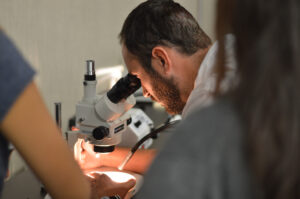Aquatic Life
Interstate Commission on the Potomac River Basin
 Animal, plant, and microscopic organisms living in water for part or all their life cycles are called aquatic life. Balanced, desirable populations of aquatic life are definitive signs of healthy, well-functioning ecosystems and sustainable water resources management.
Animal, plant, and microscopic organisms living in water for part or all their life cycles are called aquatic life. Balanced, desirable populations of aquatic life are definitive signs of healthy, well-functioning ecosystems and sustainable water resources management.
People derive valuable goods and services from Potomac waters when those populations are vigorous, resilient, and effectively performing their ecological roles [from Potomac River Basin Comprehensive Water Resources Plan, 2018].
ICPRB began studies of aquatic life in the Potomac in 1988. Projects have focused on migratory and freshwater fish, stream and river macroinvertebrates, benthic algae, phytoplankton, and zooplankton. ICPRB projects contribute to the science-based, multi-disciplinary body of information about the Potomac.
Jump to: Measure | Analyze & Report | Plan & Act
Measure
Data and Information
Data is collected when measurements are made of the natural world, samples are examined or counted in the laboratory, and information is extracted from maps, lists, photos, and other records. Sharing data and making them easy to use allows scientists to better study the Potomac’s aquatic life.
ICPRB helps the Chesapeake Bay Program assemble and manage key biological databases.
Through its internal DIME (Data Inventory, Mapping, and Exploration) project, the Commission maintains many of the datasets and related information it acquires and uses to study the Potomac.
Aquatic Animal & Plant Identification
This page has links to taxonomic lists of aquatic animal and plant species in the Potomac and nearby waters and some online taxonomic keys for identifying species in the field.
Analyze & Report
Fish
ICPRB is working with Maryland Department of Natural Resources to track trout movements in the North Branch Potomac River with acoustic transmitters. Staff are also modeling the downstream extent of potential coldwater habitat that could occur with operational changes in the summer-time releases from Jennings Randolph Lake.
In tidal waters, ICPRB monitored resident fish abundances as well as the migratory extent of alewife and blue back herring returning to the Anacostia River as fish blockages were removed in the 1990s.
Macroinvertebrates
A multi-year effort led by ICPRB developed an index of biotic integrity from macroinvertebrate data collected in streams and wadeable rivers. The “Chessie BIBI” has been used in various analyses as an indicator of biological response. It is currently used by the Chesapeake Bay Program to track stream health.
ICPRB also participated in a study that produced a multi-metric index of macroinvertebrate health from data collected in large river mainstems in the Potomac, Susquehanna, and Delaware basins.
Plankton
Scientists led by ICPRB successfully developed a plankton indexes of biotic integrity, or PIBI, for Chesapeake tidal waters from monitoring data routinely collected by the state Maryland and the Commonwealth of Virginia.
ICPRB later validated the index and the water quality binning method used to distinguish desirable (“reference”) from degraded communities.
Benthic Algae
ICPRB is involved in developing and improving methods to quantify the amounts of algae attached to stream and river bottoms and their impacts on recreational activities.
Streams and Rivers
ICPRB works with multiple agencies to study and better understand the environmental factors stressing and degrading aquatic communities in Potomac streams and rivers. Studies have focused on problems identified in specific streams and rivers (e.g., Cacapon River) and on individual stressors experienced across the basin (e.g., flow alteration).
Largest Potomac Tributaries
The North Branch Potomac, South Branch Potomac, and Shenandoah rivers are the Potomac basin’s three largest tributaries and drain two-thirds of the basin. Each has its own unique character – and problems.
Potomac River Mainstem
ICPRB recently established a baseline for the mainstem’s macroinvertebrate and freshwater mussel populations during average flow years. Parallel efforts in drought years in the future should tell us how significantly these populations are impacted by prolonged low flow.
Potomac Estuary
Several projects attempt to “integrate” various watershed, water quality, and biological results and present an ecosystem view of the estuary.
Plan & Act
Causes of Biological Impairment
In TMDL-related studies, ICPRB assists jurisdictions in identifying the environmental stressors causing biological impairments and the necessary actions to address the impairments.
Goals and Criteria
ICPRB participates in regional efforts to develop regulatory water quality criteria that protect healthy biological communities and their habitats.
Fish Restoration
A 20-year ICPRB-led stocking program has been instrumental in restoring American Shad to the Potomac Estuary.

